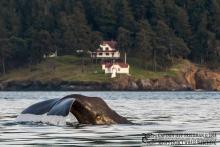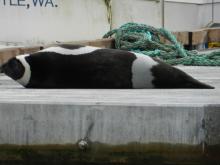Species: Histriophoca fasciata
Ribbon Seal
Species
Show on Lists
Encyclopedia of Puget Sound
Articles:
The reasons for the surprise visits are unknown, but changes in environmental conditions here or elsewhere are one possibility.

Can Puget Sound claim a new species? Ribbon seals were not previously thought to venture into the Salish Sea, but a series of sightings in Puget Sound in 2012 expands their potential range. Scientists are keeping an eye out for future sightings.

NatureServe
Ecology and Life History
Food Comments
Feeds opportunistically on crustaceans, fishes (important species include walleye pollock and arctic cod), and cephalopods. Food intake is reduced during spring molt.
Reproduction Comments
Apparently polygynous mating system. Mating occurs about the same time as weaning. Gestation, including a period of delayed implantation, lasts about 11 months. Births of single pups occur in April and early May (mainly early to mid-April). Young are weaned in 3-4 weeks, remain mostly on the ice for a few more weeks. Females becomes sexually mature at 2-4 years; many do not produce a pup until 4-5 years old; thereafter, almost all adult females give birth annually. Males are sexually mature at 3-5 years. Most probably do not live beyond 20 years.
Ecology Comments
Usually solitary, though scattered individuals may assemble on favorable ice flows (Nowak 1991). Mortality during the first four years of life is nearly 58% (Reeves et al. 1992).
Distribution
Global Range
Mainly pack ice from Hokkaido and the Sea of Okhotsk to northern Alaska and the Aleutian Islands; from late winter to early summer concentrated in ice-covered parts of the Chukchi, Bering, and Okhotsk seas and adjacent straits and bays (Nowak 1991). Most common in the Bering and Okhotsk seas; apparently relatively few summer in the Chukchi Sea (Reeves et al. 1992). Okhotsk Sea population may move into the Bering Sea for the summer.


